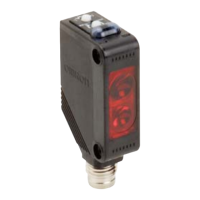E3Z-L
Ratings and Specifications
Engineering Data
Sensing method Narrow-beam reflective
Item
Model
NPN output E3Z-L61 E3Z-L66
PNP output E3Z-L81 E3Z-L86
Sensing distance White paper (100 × 100 mm): 90±30 mm
Spot diameter (typical) 2.5-mm dia. min. (at sensing distance of 90 mm)
Minimum detectable object
(typical)
0.1-mm dia. (copper wire)
Differential travel (typical) Refer to Differential Travel vs. Sensing Distance on page 2.
Light source (wavelength) Red LED (650 nm)
Power supply voltage 12 to 24 VDC ±10%, ripple (p-p): 10% max.
Current consumption 30 mA max.
Control output
Load power supply voltage: 26.4 V max.; Load current: 100 mA max.
Residual voltage: Load current of less than 10 mA: 1 V max.
Load current of 10 to 100 mA: 2 V max.
Open collector output (NPN or PNP depending on model)
Light-ON/Dark-ON selectable
Protection circuits
Power supply reverse polarity protection, Output short-circuit protection, Mutual interference prevention,
Reverse output polarity protection
Response time Operate or reset: 1 ms max.
Sensitivity adjustment One-turn adjuster
Ambient illumination
(Receiver side)
Incandescent lamp: 3,000 lx max., Sunlight: 10,000 lx max.
Ambient temperature range Operating: −25 to 55°C, Storage: −40 to 70°C (with no icing or condensation)
Ambient humidity range Operating: 35 to 85%, Storage: 35 to 95% (with no condensation)
Insulation resistance 20 MΩ min. at 500 VDC
Dielectric strength 1,000 VAC 50/60 Hz for 1 min
Vibration resistance Destruction: 10 to 55 Hz , 1.5-mm double amplitude for 2 hours each in X, Y, and Z directions.
Shock resistance Destruction: 500m/s
2
3 times each in the X, Y, and Z directions
Degree of protection IP67 (IEC 60529)
Connection method Pre-wired (standard length: 2 m and 0.5 m) Connector (M8, 4 pins)
Indicators Operation indicator (orange), Stability indicator (green)
Weight (packed state) Pre-wired type, 2 m: Approx. 65 g Approx. 20 g
Material
Case PBT (polybutylene terephthalate)
Lens Modified polyarylate
Accessories Instruction manual (Mounting Brackets must be ordered separately.)
Operating Range Excess Gain vs. Sensing Distance
Sensing Object Size vs. Sensing Distance
Spot Diameter vs. Sensing Distance Differential Travel vs. Sensing Distance
10
8
6
4
2
0
−2
−4
−6
−8
−
10
Distance X (mm)
Sensed object: white paper
(100 × 100 mm)
Distance Y (mm)
0255
275
75
100 125 150 175 200 225
250
0
100
70
50
30
10
7
5
3
1
0.7
0.5
0.3
0.1
Distance

